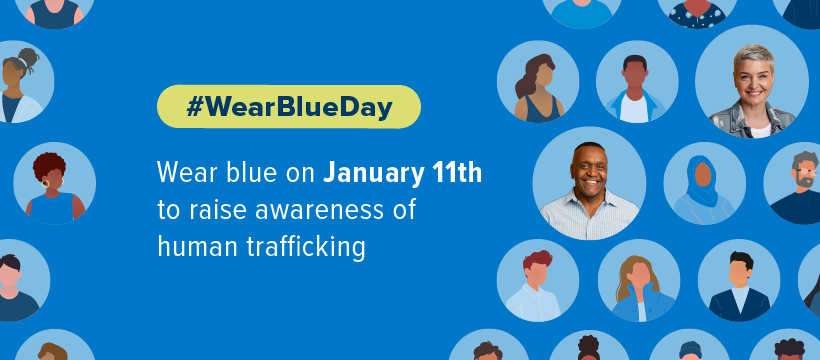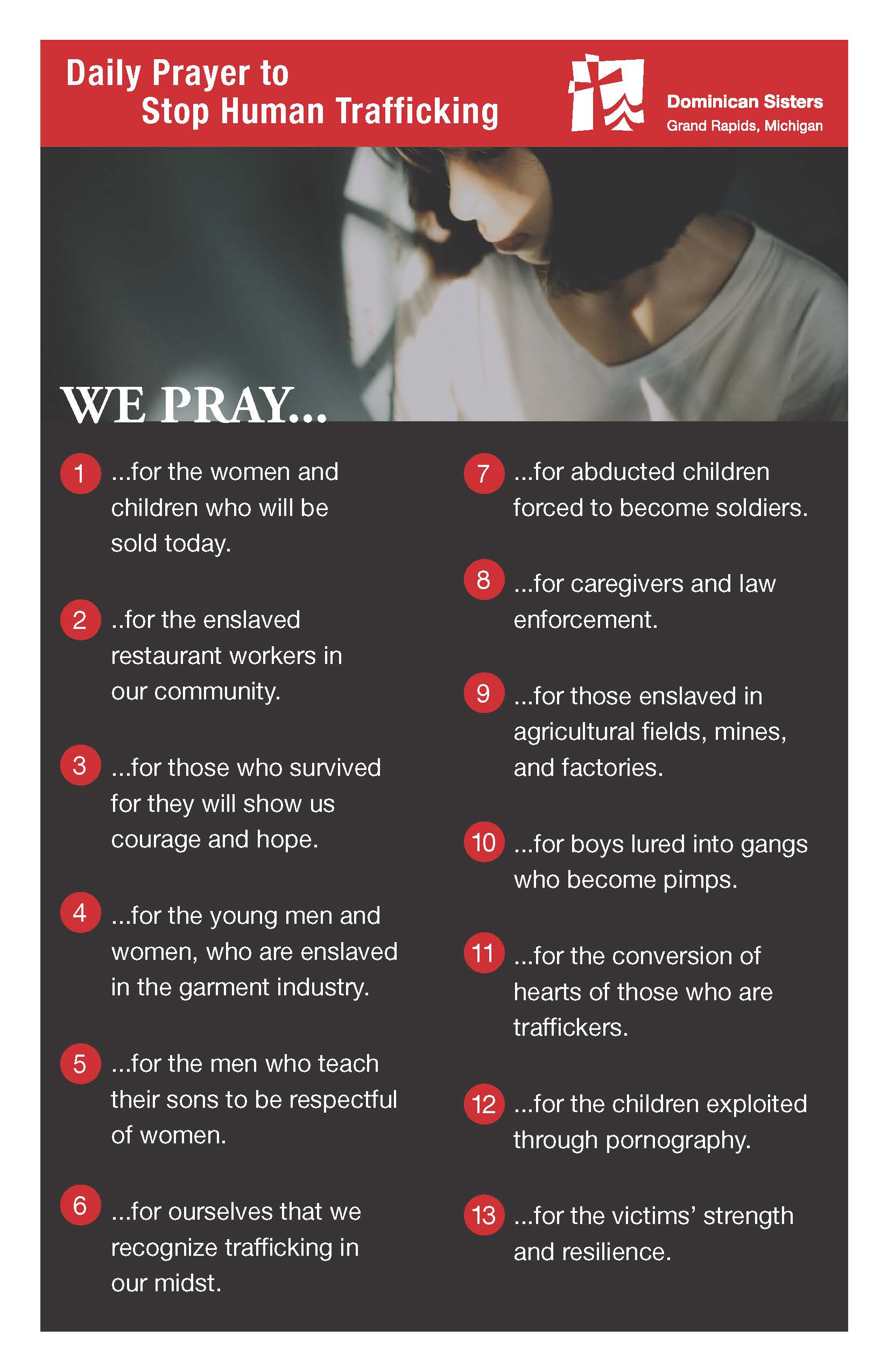
by Brigid Clingman, OP, Promoter of Justice
January 11 is #WearBlueDay. The Dominican Sisters and Associates of Grand Rapids welcome and encourage you to wear blue on Jan. 11 (or all month) as a sign of your awareness of this Justice issue and desire to support human trafficking victims and survivors.
In 2007 Congress designated January 11 as National Human Trafficking Awareness Day. #WearBlueDay, also known as National #HumanTrafficking Awareness Day, is observed each year on January 11.
The U.S. Department of Homeland Security Blue Campaign initiated #WearBlueDay to raise awareness of human trafficking and to show support for its victims and survivors. Learn more at https://go.dhs.gov/ZSX

We Pray
We Study: Human Trafficking is a Crime against Humanity
“The Nexus Between Human Trafficking and Forced Migration” is a guest article from the Alliance to End Human Trafficking & National Advocacy Center of the Sisters of the Good Shepherd
Human Trafficking is a form of modern-day slavery that involves the use of force, fraud, or
coercion to exploit another; to obtain labor or a commercial sex act. It is a crime under both
U.S. and international law, and a crime against humanity. It dehumanizes and commodifies
human beings, depriving them of their dignity, persons made in the image of God. And it
denies their human rights: the right to life, security, freedom of movement, and the freedom
from torture and degrading treatment. It is antithetical to the tenets of our Catholic faith and
the values of this nation.
In an address on April 11, 2019, the Holy Father Pope Francis said human trafficking
“constitutes an unjustifiable violation of the freedom and dignity of the victims, constitutive
dimensions of the human being wanted and created by God. This is why it is considered a
crime against humanity. Trafficking seriously damages humanity as a whole, tearing apart the
human family and the Body of Christ.” (Catholic News Agency) The nature of human
trafficking makes it difficult to accurately describe its scope and number its costs. The
National Human Trafficking Hotline reports that, “[d]espite growing awareness about this
crime, human trafficking continues to go underreported due to its covert nature,
misconceptions about its definition, and a lack of awareness about its indicators.” (National
Human Trafficking Hotline).
While the 2020 Global Report on Trafficking in Persons estimates that in 2018
approximately 50,000 people were identified as living in conditions of human trafficking on
any given day, the data only reflects trafficked persons who were in contact with authorities.
It does not reflect the actual prevalence of the crime or the hidden number of victims of
commercial sexual exploitation, forced labor, and forced marriage. The International Labor
Organization estimates that their suffering earns their traffickers approximately 150 billion
dollars annually.
The elimination of human trafficking is a priority issue for the Catholic Church and all
people of good will. Every life is a gift from God and is sacred. Every human being deserves
to be protected and nurtured. We each have a responsibility to fight against the violation and
degradation of our brothers and sisters.
Those Forced to Migrate are Especially Vulnerable
Traffickers thrive where vulnerability is high; where people are desperate, and their options
are limited or nonexistent. People on the move and recent immigrants are at particular risk of
exploitation by traffickers because of their precarious social and economic circumstances.
The International Organization for Migration estimates the number of international migrants
to be at least 281 million people. They are refugees, asylum seekers, labor migrants, and
those displaced by conflict or natural disasters. They are fleeing floods, famine, war,
violence, endemic poverty, organized crime, and political corruption and the effects of
climate change. They are both desperate and resilient.
The adverse circumstances that force people to flee their homes can lead unknowing
migrants into the hands of corrupt labor recruiters, organized trafficking networks, or
individual situations of extortion. The very status of people as migrants, especially irregular
migrants, makes them vulnerable. “Moreover, irregularity often leads migrants to work in
sectors prone to exploitation, such as in the fishing industry in South-East Asia, the
agricultural sector in Europe, and construction jobs in Northern America.” (World Migrant
Report 2022,Chp 10, 258)
Immigration and human trafficking are clearly interconnected, especially in the United
States. Polaris estimates over 70 percent of persons trafficked in the United States each year
are immigrants (Polaris Analysis of 2021 Data from the National Human Trafficking Hotline,
pg. 8). Migrants and immigrants, including children, are sold for sex and labor and exploited
across a range of industries in the United States. A 2023 New York. Read full article

